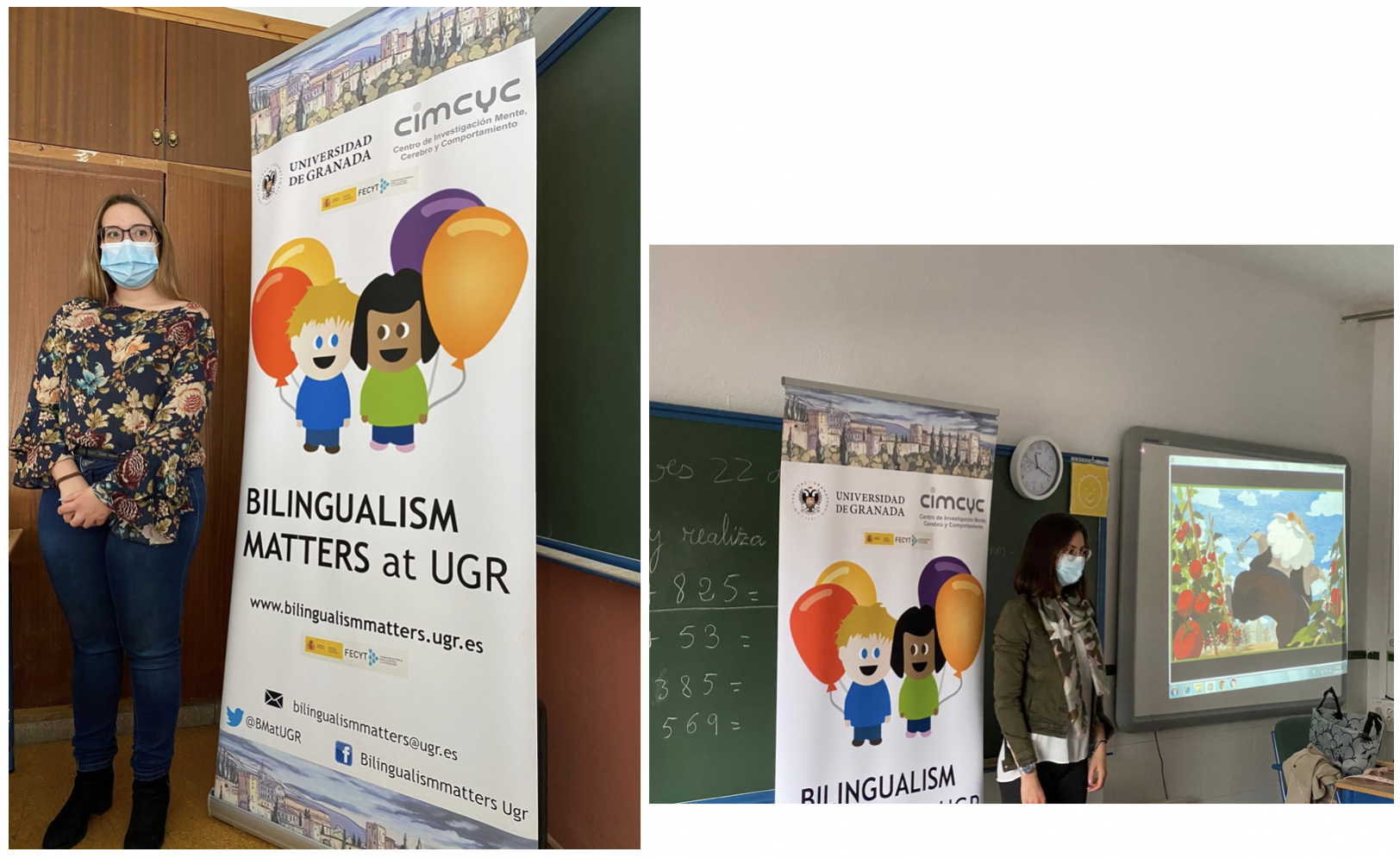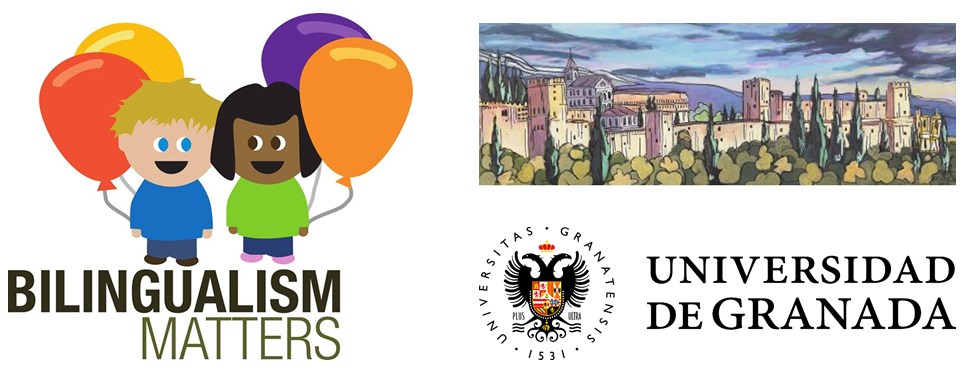CEIP Profesor Tierno Galván (Armilla) y EIM Luna (Granada) // Local schools: Professor Tierno Galván Elementary & Luna Preschool
por Marta Reyes Sánchez & Alejandra Marful
Durante el mes de abril, el equipo de Bilingualism Matters UGR se ha trasladado a dos centros educativos de la provincia de Granada para impartir de forma presencial el taller que aborda la temática de cerebro, bilingüismo y ciencia. Estas actividades se llevan a cabo dentro del proyecto “¿Cómo conviven dos idiomas en el cerebro? Transfiriendo la investigación desde el laboratorio a la sociedad”, financiado por el FECYT y el Ministerio de Ciencia e Innovación (FCT-19-15358).
During the month of April, our Bilingualism Matters UGR team visited two education centers in Granada province in order to impart in person workshops about the brain, bilingualism, and science. These activities are a part of our project “How do languages co-exist in the brain? Relaying evidence from the laboratory to our society”, which is financed by the Spanish Foundation of Science and Technology (FECYT) and the Ministry of Science and Innovation (FCT-19-15358).
En el CEIP Profesor Tierno Galván (Armilla), los talleres iban dirigidos al alumnado de 1º y 2º de educación primaria. El tema central ha sido qué es hacer ciencia y qué significa ser bilingüe. El taller, que se realizó en cada una de las clases, con un total de cuatro aulas, daba comienzo con un cuentacuentos digital. Las láminas fueron proyectadas y cada una de ellas era narrada en tres idiomas de forma consecutiva: castellano, inglés y árabe fusha. Más tarde, el alumnado participó activamente realizando pequeños experimentos y planteando preguntas y cuestiones súper interesantes. Para nuestra grata y agradable sorpresa, durante el cuentacuentos hubo alguien quien reconoció el árabe fusha, una lengua minoritaria en este contexto y de forma entusiasta alzó la voz para compartir con el resto de la clase que estaba entendiendo. Este hecho subraya la importancia de poner en valor en el aula lenguas minoritarias para fomentar la diversidad cultural y lingüística en nuestro entorno.
At Profesor Tierno Galván Elementary located in Armilla, the workshops were put on for 1st and 2nd graders. The central theme was: what does “doing science” mean, and what does being bilingual mean? The workshop started with digital storytelling for each class (we visited 4 classes in total). The pages of the story were projected on the screen and were narrated in 3 languages, consecutively: Spanish, English, and Fusha Arabic. Afterwards, the students participated in short activities including experiments and a question session. Much to our pleasant surprise, during the storytelling activity, there was a student who knew Fusha Arabic, which is a minority language in the Granadian context. The student excitedly exclaimed and shared with the rest of the class that they were understanding what was being said. This underlines the importance of valuing minority languages in classroom settings to promote cultural and linguistic diversity in our surroundings.
Además, con el objetivo de extender el alcance e impacto del taller más allá de la presencia de las investigadoras en el aula, se propuso un maratón de dibujos. El alumnado de 6 y 7 años realizó bonitos dibujos bajo el título “La ciudad de los idiomas”. Antes, ya había recibido un pequeño detalle por parte del equipo Bilingualism Matters UGR: un bolígrafo con luz y un carné oficial de investigador. Se les instó a “investigar cómo funcionaba el boli” y una vez descubierto pudieron personalizar el carné, de modo que … ¡TODO EL MUNDO ERA AUTÉNTICO CIENTÍFICO!
In addition, since our project goal is to extend the reach and impact of the workshop beyond the classroom, we challenged the students with a drawing contest. The 6 and 7 year olds created beautiful drawings titled “The city of languages”. Each student went home with a little gift as well: a light up pen and an “Investigator ID card”. We told them, “you need to investigate how the pen lights up” (it wasn’t as simple as the touch of a button); once they figured it out, they put their names on the Investigator ID card. This way, all of them were authentic scientists!
En el caso de la EIM Luna (Granada), la actividad consistió en un cuentacuentos con Kamishibai (pequeño teatro de madera para contar cuentos a niños/as en grupo) sobre el cuento tradicional neozelandés titulado “Cómo Maui capturó el sol” que se narró en español y en inglés a la clase de 3-4 años. La profesora Alejandra Marful, que se encargó de esta actividad, destaca el gran interés de los/las pequeños/as ante el aprendizaje de nuevos idiomas cuando este acercamiento se realiza desde una perspectiva lúdica.
At Luna Preschool, located in Granada city, the activity was storytelling, Kamishibai style. This Japanese story telling technique includes a wooden theater model that helps to narrate to a group of children. Professor Alejandra Marful narrated the traditional Polynesian story “How Maui captured the Sun”, in Spanish and in English for a class of 3 and 4 year olds. Marful, who was in charge of the activity, highlights the great interest the little ones have in learning new languages when the topic is approached from a playful perspective.
Sin duda, ambos fueron encuentros enriquecedores. El hecho de poder realizarlo de forma presencial e interactuar con los/as pequeños/as, devuelve la magia al taller.
Without a doubt, the activities at both schools were enriching. We experienced a newfound magic during the workshops, which can definitely be attributed to being able to interact in person with the children.
Si quieres estar al día de estas y otras noticas relacionadas con nuestro trabajo, recordad, que podéis seguirnos en nuestras redes sociales // If you want to be up to date on our activities, remember, you can follow us on our social media: Facebook. Twitter.


